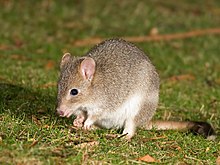Bettongs, species of the genus Bettongia, are potoroine marsupials once common in Australia. They are important ecosystem engineers displaced during the colonisation of the continent, and are vulnerable to threatening factors such as altered fire regimes, land clearing, pastoralism and introduced predatory species such as the fox and cat.
| Bettongs[1] | |
|---|---|
 | |
| Eastern bettong | |
| Scientific classification | |
| Domain: | Eukaryota |
| Kingdom: | Animalia |
| Phylum: | Chordata |
| Class: | Mammalia |
| Infraclass: | Marsupialia |
| Order: | Diprotodontia |
| Family: | Potoroidae |
| Subfamily: | Potoroinae |
| Genus: | Bettongia J. E. Gray, 1837 |
| Type species | |
| Bettongia setosa J. E. Gray, 1837 | |
| Species | |
Conservation status
All species of the genus have been severely affected by ecological changes since the European colonisation of Australia. Those that have not become extinct became largely confined to islands and protected reserves and are dependent on re-population programs. The diversity of the genus was poorly understood before their extirpation from the mainland, and new taxa have been identified in specimens newly discovered and already held in museum collections.[2] In August 2021, 40 bettongs were released in different parts of South Australia after being raised in captivity to increase their numbers.[3]
Taxonomy
Four extant species are recognised in the work Mammal Species of the World (2005):[1]
- Bettongia gaimardi, Eastern bettong, also known as the Tasmanian bettong
- Bettongia lesueur Boodie
- Bettongia penicillata Woylie
- Bettongia tropica Wakefield, 1967.[4] Northern bettong
In addition, at least three extinct species are known:
- Bettongia moyesi, Middle Miocene bettong from Riversleigh[5]
- Bettongia pusilla, Nullarbor dwarf bettong, known only from subfossil remains, probably became extinct after colonisation
- Bettongia anhydra, described in 2015 from a specimen collected in 1933 near Lake Mackay, Northern Territory.[2]
The phylogeny of the genus has seen a grouping of 'brush-tailed' taxa allied within the genus Bettongia, and this includes the extant species Bettongia gaimardi, B. tropica and B. penicillata.[2]
A conservative arrangement of modern and fossil taxa of Bettongia may be summarised as[6]
- family Potoroidae:
- subfamily †Bulungamayinae
- subfamily †Palaeopotoroinae
- subfamily Potoroinae
- genus Aepyprymnus
- genus Bettongia
- species †Bettongia anhydra
- species Bettongia gaimardi
- species Bettongia lesueur
- species †Bettongia moyesi
- species Bettongia penicillata
- species †Bettongia pusilla
- species Bettongia tropica
- genus †Milliyowi
- genus †Caloprymnus
- genus Potorous
- genus †Purtia
- genus †Wakiewakie
- genus †Gumardee
The species Aepyprymnus rufescens is referred to as the rufous bettong,[7] despite not being a member of the genus Bettongia.
See also
- Kangaroo rat – a heteromyid rodent of North America
References
Wikiwand in your browser!
Seamless Wikipedia browsing. On steroids.
Every time you click a link to Wikipedia, Wiktionary or Wikiquote in your browser's search results, it will show the modern Wikiwand interface.
Wikiwand extension is a five stars, simple, with minimum permission required to keep your browsing private, safe and transparent.
